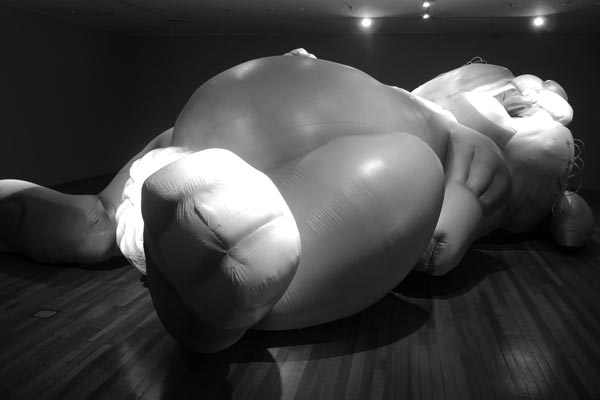Michael Parekowhai
Jim McMurty
Exhibited until 9 November 2014
Michael Parekowhai (born Porirua, 1968) is one of New Zealand’s most important contemporary artists.
Parekowhai acquired his BFA (1990) and his MFA (2000) from Elam School of Fine Arts, University of Auckland. In 2001 Michael was awarded an Arts Foundation of New Zealand Laureate and since then, while still exhibiting, Parekowhai has been an Associate Professor in Fine Arts at the University of Auckland. His exhibition history spans almost two decades.
Creating a broad range of work across a range of media, including sculpture, installation and photography, Parekowhai’s work plays with space and theme in a quirky, subtle and humorous, yet still challenging, manner.
I have been a fan of Parekowhai’s work since I first saw the images of his two inflatable bunnies (Jim McMurty and Cosmo) in New Zealand art collectors Jim and Mary Barr’s book, Reboot, which is a reflective compilation of their personal collection from a range of renowned contemporary New Zealand artists. I purchased my copy for only $20 at the DPAG, and I really rate it as a simple, but significant, art read.
Initially the bunnies were designed for the three- month-long 2002 Scape: Art and Industry Urban Arts Biennial, where Parekowhai suggested that he turn Cathedral Square in Christchurch into a playground for the bunny and its partner (Cosmo) – but the proposal was ill-fated, as was the consent process, so it took a little longer and they never quite made it into Cathedral Square. However, Jim McMurty and Cosmo have been well travelled-since, and now in 2014, the bunnies have been exhibited in places as far as Korea, Canada and Lithuania. Now, finally, Jim McMurty is here at the Dunedin Public Art Gallery – just filling space snoozing and looking cute. I am thrilled to have been able to see Jim McMurty in real life.
The inflatable Jim McMurty is characteristically large in scale, and sprawls itself flat on its back across the gallery floor, at 12 metres long and 4.5 metres wide. With limp whiskers and a bushy tail, one eye is closed, and the tongue hangs lifelessly out one side of its mouth, as if stars should be circling the rabbit’s head. Aesthetically, the piece is comical and cartoonish and it reminds me of Bugs Bunny or Peter Rabbit. In a word, it’s quite charming. Even its size isn’t uncomfortably confrontational, demonstrating how Parekowhai cleverly maintains subtlety with what I would call super-scale objects, as a real life bunny would probably be smaller than Jim McMurty tongue.
There has been controversy surrounding the significance of the bunny/bunnies, with people questioning: What does it represent? What does it mean? How is it art? But for me, that is the whole point of it. It shows that art cannot be defined by one set of rules or expectations. The bunny for one person is cute and childish and adorable, and for another it is a weird oversize representation of a colossal pest. For some it is a symbol of colonialism, and for others, a mere mascot of popular culture.
I was talking to someone who was at the Dunedin Public Art Gallery who shared the same passionate interest in Parekowhai as I do, and they mentioned they had encountered a visitor who had viewed the piece and didn’t “get it” because it “didn’t look like art at all.”
The mere fact that the piece exists as an aesthetic object in a gallery I think is what constitutes it as “art” for the general public, but on a more profound artistic level, it is important to understand when looking at art (particularly Jim McMurty), that the object is not confined by any (nonexistent) “rules” or any specific identity, or any specific anything, for that matter – it merely exists as an open possibility of meaning.
Walter Pater (my favourite aesthetic theorist) once wrote that what makes it art is that some mood of passion or insight or intellectual excitement becomes irresistibly real and attractive and fun for us for only that moment when we look at the object; and that’s why I like Parekowhai’s bunny so damn much. It brings together memories of childhood, moods of creative impulse, and little moments of intellectual reflection.
The second version of the bunny, Cosmo (not on display) is part of the National Gallery of Victoria Collection and that’s my next Parekowhai stop. On loan for an extended duration, the bunny will be resting in the DPAG for a while longer, and it shouldn’t be left unseen.



